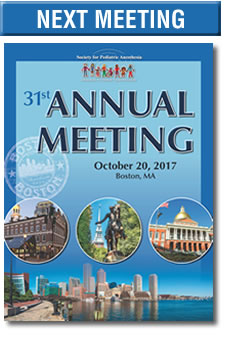spa-aap reviews
Saturday Session I - Philip, Amy, and the Musician Formerly Known as Prince: Opioids - Time for a change
Reviewed by Dean Laochamroonvorapongse, MD, MPH
OHSU Doernbecher Children’s Hospital
This session was moderated by Jeffrey L. Galinkin, MD, FAAP (Children’s Hospital of Colorado) and featured two presentations focused on responsible opioid prescribing practices with the goal of reducing opioid abuse. The first presentation was “The Opioid Problem: How clinical research leads to discovery” by Myron Yaster, MD (Children’s Hospital of Colorado). “The world is full of obvious things that nobody by any chance ever observes.”
Dr. Yaster used this Sherlock Holmes quote to describe how he initially began a twelve year process of discovery and research on the non-medical use of prescription opioids (NMUPO) while at Johns Hopkins Hospital. He noticed that ward nurses were frequently calling the pediatric pain team to rewrite erroneous opioid prescriptions by surgeons and decided to study the scope of the problem. An analysis of 314 opioid prescriptions written for 241 patients at discharge found that 82% of the prescriptions contained one or more errors, most commonly missing or wrong patient weight (77%), incomplete dispensing information (53%), and no, or wrong, date on prescription (6%). Three percent of prescriptions had the potential for significant medical injury and were considered potential adverse drug events (J Pain. 2009 Feb;10(2):160-6).
Dr. Yaster stated that the shockingly high error rate for opioid prescriptions written by physicians would be unacceptable in any other industry; as a result of these findings, a computerized, web-based, narcotic prescription writer that has weight-based dosing logic and alerts was deployed at Johns Hopkins Hospital in September 2005, which reduced the serious error rate to near zero. A subsequent analysis of 34,218 pediatric outpatient narcotic prescriptions written using this system from 2007-2014 found that the most commonly prescribed opioid was oxycodone without acetaminophen, accounting for 73% of prescriptions (Anesth Analg. 2016 Mar;122(3):807-13). The prodrug codeine with acetaminophen was prescribed to only 7% of patients, which likely reflects the increased awareness of the substantial genetic variability in its conversion to morphine by CYP2D6 and the 2013 FDA “black box” warning on its use in children post-adenotonsillectomy. Dr. Yaster and his colleagues also discovered that regardless of opioid prescribed, an average of 106mL opioid was dispensed for liquid formulations, while an average of 51 opioid tablets were dispensed.
Since the large quantity of opioid dispensed lends itself to non-medical diversion and abuse, leading Dr. Yaster to ask, “Why do doctors dispense so much medicine when they prescribe opioids to their patients?” In a single center study, he found that 48% of all opioid prescriptions were written by orthopedic surgeons, so perhaps these busy surgeons did not want additional patient phone calls or poor patient satisfaction scores? Only 30% of the dispensed opioid was actually consumed by the patient; furthermore, only 18% of families were told how to dispose of leftover opioids, and only 4% actually did so. Other studies have also shown that when morphine is prescribed for post-surgical pediatric patients, most parents administered two doses or less, or 9.2% of prescribed doses (J Pediatr. 2015 Sep;167(3):599-604).
The adoption of pain as a “5th vital sign” in the early 1990s was a game changer in medicine, leading to a dramatic increase in hydrocodone and oxycodone prescriptions in the United States. This is mirrored by a staggering increase in deaths from prescription opioid overdose; annually, there are 16,000 deaths, 1.4 million ER visits, and $72 billion in medical costs attributable to opioid abuse. The U.S. currently accounts for 4% of the world’s population but consumes 80% its opioids.
Dr. Yaster emphasized that our current opioid prescription practices, which lead to large quantities of unused opioid remaining in our kitchen or bathroom medicine cabinets, are a set up for NMUPO by adolescents. Twenty seven percent of adolescents mistakenly believe that misusing prescription drugs is safer than using street drugs, while 33% believe “it’s okay to use prescription drugs that were not prescribed to me to deal with an injury, illness or physical pain.” Due to their still-developing prefrontal cortex, adolescents are especially prone to impulsive, risk-taking behaviors and subsequent heroin addiction, since it is cheaper to obtain on the street compared to oxycodone or hydrocodone.
To conclude his informative presentation, Dr. Yaster stressed that while we develop evidence based dispensing guidelines and develop new methods of drug disposal, humane pain management with opioids is still needed for most types of moderate to severe pain. He also emphasized the need to get medical students, residents and fellows involved in this type of research and piquing their interest in the joy of discovery and the ever-changing practice of medicine.
The session’s second presentation, “Challenging the Opioid Paradigm,” was given by Tracy Jackson, MD (Vanderbilt University Medical Center). Pain physicians are often focused on nociceptive modulation with prescription medications and procedures we can bill for instead of taking into account the patient’s subjective pain experience. Dr. Jackson urged the audience to recognize that “when something doesn’t make sense, it doesn’t make sense for a reason,” and provided us with four main reasons why “something doesn’t make sense” in pediatric chronic pain patients.
The first reason is misdiagnosis, leading to both the patient and clinician’s misperception of where pain is actually coming from. As an example, Dr. Jackson cited that 70% of patients will have lumbar disc abnormalities on MRI without pain. However, if a patient with lower back pain is found to have a herniated L5-S1 disc, it is automatically assumed to be the root cause of the pain and becomes the target for all subsequent interventions.
Another option for why pain “doesn’t make sense” is that the patient is not participating in their own care or has unrealistic expectations. In the case of lower back pain patients, Dr. Jackson suggested that many patients have significant biomechanical imbalances (accumulated over years of sitting at a desk or poor posture) that they are not willing to address with exercise and physical therapy. For pediatric patients, who cannot choose their home environment, she cited substance misuse in the household as an “adverse childhood event” (ACE) that may impair recovery.
Furthermore, Dr. Jackson attributed a dysfunctional pain-processing system (i.e., baseline central sensitization) as the root cause of virtually all pain that “doesn’t make sense” in chronic pain patients. She observed that most children say “their tummy hurts” when they cannot go to school and suggested that this central sensitization occurs early in children with functional abdominal pain. Children with functional abdominal pain are four times more likely to develop chronic pain as adults. In addition to this, Dr. Jackson emphasized the significant overlap between chronic pain and mood syndromes.
Recently, three psychosocial risk factors were consistently identified as promoting the development of chronic pain of all types in both pediatric and adult patients (J Pain. 2016 Sep;17(9 Suppl):T70-92). The first risk factor is negative affect, with depression and anxiety increasing the risk of developing chronic pain more than pain intensity itself. Specifically, catastrophizing (e.g., patients that insist their pain is “12 out of 10”) was identified as the most consistent independent risk factor for poor outcomes. Childhood trauma, including abuse/ACE, prolonged hospitalizations, death of a parent, and financial crisis lead to a 2-3 fold increase in risk of developing chronic pain as an adult. The third risk factor is pathologic relationships, including overly solicitous parents or partner, lack of social support, and parents with anxious or avoidant attachment styles.
In contrast, protective factors against the development of chronic pain include active coping techniques, gratitude, positive visualization, mindfulness meditation, and high functioning family units, strongly suggesting that low cost, non-medical interventions work better that our current paradigm of opioids and pain procedures. Dr. Jackson mentioned an abnormal relationship with opioids as the fourth and final reason why patients may have pain that “doesn’t make sense.” One percent of people in the United States have opioid use disorder, and the children of parents with opioid use disorder (OUD) are more likely to develop substance use disorders, suicidal ideation, chronic pain, and ADHD. Regarding ADHD, Dr. Jackson cited recent literature suggesting that treating adolescents with stimulants for ADHD did not increase the risk of developing OUD, but the non-medical use of these stimulants in conjunction with adverse childhood events multiplied the risk of developing substance use disorder.
Dr. Jackson ended her entertaining and thought-provoking presentation by emphasizing that there is no quick fix for a chronic problem and that chronic pain is not an opioid deficiency. There is a need to create pediatric pain centers with interdisciplinary functional rehabilitation programs that combine treatment for both chronic pain and opioid use disorder, as this has been shown to be the most effective approach. Dr. Jackson concluded by urging the audience to embrace this holistic, integrative approach by asking about pain at every location to prevent misdiagnosis, addressing “the awkward stuff,” involving family members, and getting creative about promoting the “hippie stuff” that works, such as yoga and meditation.






